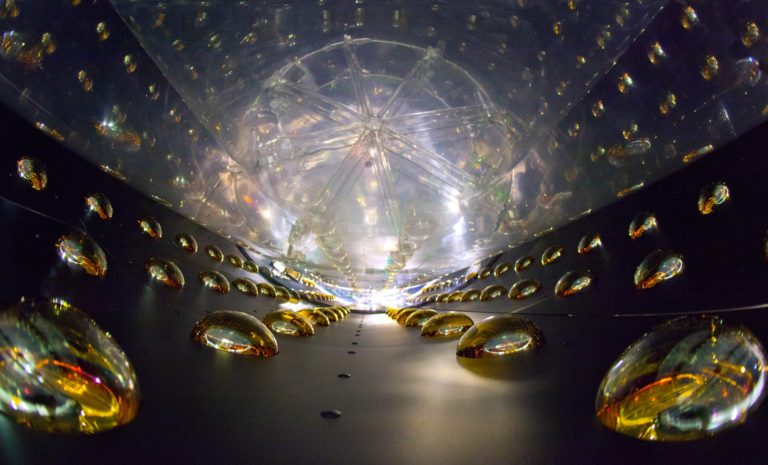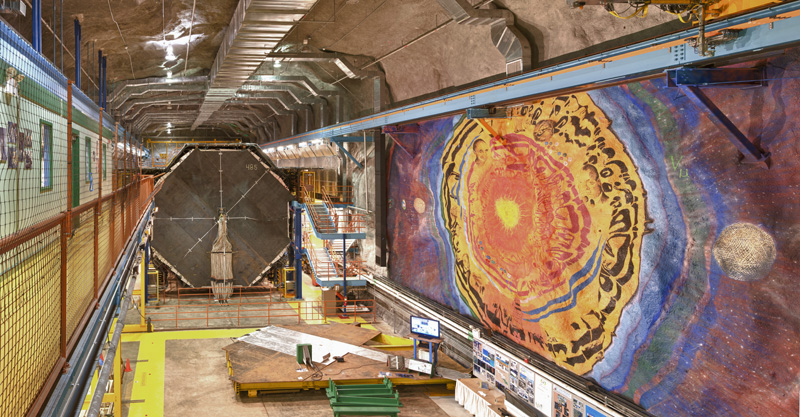UCI physicists play a leading role in an international quest to find sterile neutrinos

Neutrino detectors at the Daya Bay experiment in China, one of two international groups that have come together to put strict limits on what can be construed as a “sterile neutrino.”
Irvine, Calif., Aug. 10, 2020 — An international group of more than 260 scientists, including physicists at the University of California, Irvine, has produced one of the most stringent tests for the existence of sterile neutrinos to date.
The scientists from two major international experimental groups – MINOS+ at the Department of Energy’s Fermi National Accelerator Laboratory near Chicago and Daya Bay in China – recently formed a collaboration to hunt for the mysterious particles.
Their initial joint efforts, reported on today in Physical Review Letters, rule out oscillations into one sterile neutrino as the primary explanation for unexpected observations from recent experiments conducted at the Liquid Scintillator Neutrino Detector at Los Alamos National Laboratory in New Mexico and at Fermilab’s MiniBooNE experiment.
“We would all have been absolutely thrilled to find evidence for sterile neutrinos, but the data we have collected so far do not support any kind of oscillation with these exotic particles,” said Daya Bay scientist Pedro Ochoa-Ricoux, UCI associate professor of physics & astronomy, whose team played a leading role in deriving the results.
MINOS+ studies the disappearance of muon neutrinos produced by a Fermilab accelerator and propagating to an underground detector in northern Minnesota 735 kilometers away. Daya Bay uses eight identically designed detectors to precisely measure how electron neutrinos emitted by six nuclear reactors in China “disappear” as they morph into other types.
Neutrinos are elementary particles that, like electrons, cannot be broken down into smaller components. They are unlike any other particle known to exist in that they are able to penetrate extremely large amounts of matter without stopping. If a neutrino is shot from the surface of Earth toward its center, there is a very large probability that it will emerge intact on the other side.
There are three known types of neutrinos: electron, muon and tau. About two decades ago, scientists found that they can morph from one type into another through a phenomenon called “neutrino oscillation,” a discovery that was awarded the 2015 Nobel Prize in physics. A neutrino created as an electron-type traveling through space can later be identified as a muon type or tau type.
Even though the vast majority of accumulated data to date can be explained by three known neutrinos, a few experiments have reported anomalous observations suggesting the existence of additional types. Among these are the LSND experiment at Los Alamos and the MiniBooNE experiment at Fermilab.
Both exposed their detectors to a beam of muon neutrinos and reported an excess of electron neutrino candidate events beyond what would be expected from oscillations involving only the three known types of neutrino, but possibly reconcilable if a new type of neutrino – a sterile neutrino – was involved. Sterile neutrinos would not be directly detectable, but their oscillation with the three known neutrinos would provide a unique pathway to establish their existence.
However, the new results from Daya Bay and MINOS+ question this possibility as an explanation of LSND and MiniBooNE results.

“The stakes are high; if this tantalizing interpretation of the anomalous results was confirmed, a revolution in physics would ensue. Sterile neutrinos would become the first particles to be found outside the Standard Model, our current best theory of elementary particles and their interactions,” said Ochoa-Ricoux. “They could also be a candidate for dark matter and might have important consequences in cosmology.”
Alexandre Sousa, associate professor of physics at the University of Cincinnati and one of the MINOS+ scientists who worked on the analysis, said, “This close collaboration of MINOS+ and Daya Bay scientists enabled the combination of two complementary world-leading constraints on muon neutrinos and electron antineutrinos disappearing into sterile neutrinos.”
The disappearance of both particles needs to occur if electron (anti)neutrinos are to appear in a muon (anti)neutrino source via sterile oscillations with a single sterile neutrino.
“So, the combined result is a very powerful probe of the sterile neutrino hints we have to date,” he said.
The analysis reported by Daya Bay and MINOS+ not only ruled out the specific kind of sterile neutrino oscillation that would explain the anomalous results but also looked for other sterile neutrino signatures with never-before-achieved sensitivity, yielding some of the most stringent limits on the existence of these elusive particles to date.
“This joint effort very effectively tackles a fundamental problem in physics,” said Daya Bay spokespersons Kam-Biu Luk of Lawrence Berkeley National Laboratory and UC Berkeley, and Jun Cao of the Institute of High Energy Physics in Beijing. “While there is still room for a sterile neutrino to be lurking in the shadows, we have significantly shrunk the available hiding space.”
UCI has a long history in neutrino research, dating back to the founding dean of the School of Physical Sciences Frederick Reines, who won the Nobel Prize in Physics in 1995 for being the first to detect the ghostly particles. Multiple UCI researchers are currently involved in neutrino research projects, including the Deep Underground Neutrino Experiment, the Super Kamiokande experiment in Japan, and Watchman, a project to detect neutrinos emitted by rogue nuclear activities.
UCI collaborators in this project included postdoctoral scholar in physics & astronomy Bedrich Roskovec; graduate students Olivia Dalager, Roberto Mandujano, and Kaleb Hartfield; and undergraduate students Yansong Huang and Jay Mosley.
About the University of California, Irvine: Founded in 1965, UCI is the youngest member of the prestigious Association of American Universities. The campus has produced three Nobel laureates and is known for its academic achievement, premier research, innovation and anteater mascot. Led by Chancellor Howard Gillman, UCI has more than 36,000 students and offers 222 degree programs. It’s located in one of the world’s safest and most economically vibrant communities and is Orange County’s second-largest employer, contributing $5 billion annually to the local economy. For more on UCI, visit www.uci.edu.
Media access: Radio programs/stations may, for a fee, use an on-campus ISDN line to interview UCI faculty and experts, subject to availability and university approval. For more UCI news, visit news.uci.edu. Additional resources for journalists may be found at communications.uci.edu/for-journalists.
